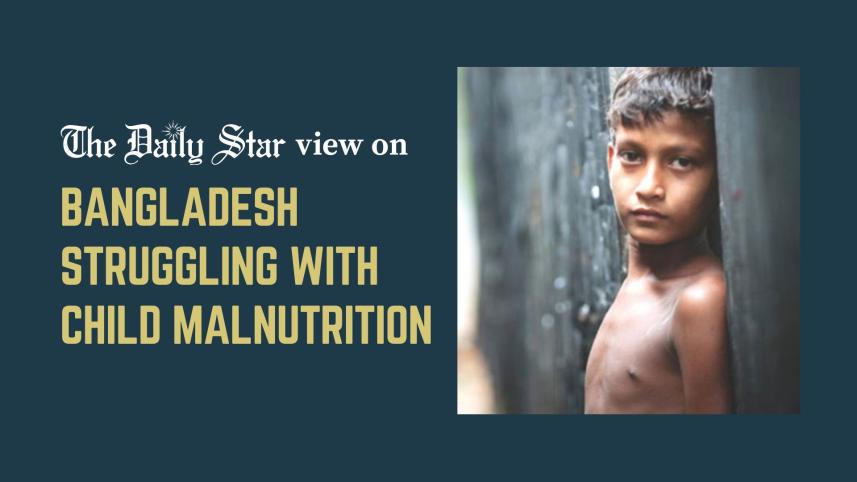We must not let malnutrition threaten our future

It is concerning that Bangladesh is not making significant progress in reducing child malnutrition, despite its success in lowering infant and maternal mortality rates. Almost two-thirds of children under age five face food poverty in the country, while one-fifth experience extreme food poverty. This means a large number of young children don't get to eat sufficient amounts of breastmilk, eggs, dairy, grains and legumes, meat and fish, and vitamin A-rich fruits and vegetables, as recommended by WHO and Unicef. As a result, 24 percent of children across the country suffer from stunting (shorter height for age), with the incidence being higher in urban slums, 11 percent from wasting (low weight for height), and 22 percent from underweight (low weight for age)—prevalence rates that carry high public health significance as per WHO.
While rising food prices have been limiting people's ability to provide nutritious meals to their families, early marriage is another key contributor to malnutrition. Bangladesh has the highest prevalence of child marriage in South Asia. Adolescent mothers, mostly from low-income families and often suffering from anaemia and malnutrition themselves, give birth to underweight children with poor brain development. This leads to intergenerational malnutrition, with children suffering from stunting, wasting and underweight conditions. Stunting hampers learning ability and academic performance, which can put children at a disadvantage in adulthood and further entrench the cycle of poverty. Meanwhile, wasting weakens the immune system, placing children's lives at a greater risk, according to Unicef.
Although various measures have been taken over the years to address the root causes of malnutrition—such as poverty, lack of education, and inadequate healthcare—these efforts have largely focused on awareness-building. Experts now recommend scaling up direct intervention programmes. Currently, per capita nutrition spending stands at $18, of which 98 percent is allocated to "nutrition-sensitive" programmes, and only two percent to direct nutrition interventions. Thankfully, the government has decided to restart the School Feeding Programme in government primary schools across 150 poverty-prone upazilas, providing children with eggs, UHT milk, bread rolls, bananas, and fortified biscuits five days a week.
However, according to a Jugantor report, the programme is already delayed and allegations of irregularities have surfaced in the tender process for food suppliers. The government must investigate these allegations and ensure that food quality and quantity are not compromised. Strict monitoring is essential to guarantee that the intended beneficiaries of the programme are not deprived. Additionally, separate interventions should be designed for urban slums, where stunting rates are especially high. Efforts such as maternal supplementation, promotion of breastfeeding, dietary diversity, and hygiene practices must be strengthened via frontline health workers. Finally, ministries including health, food, social welfare and education must coordinate effectively to ensure that the allocated resources are fully utilised and that programmes deliver the desired nutritional outcomes.



 For all latest news, follow The Daily Star's Google News channel.
For all latest news, follow The Daily Star's Google News channel. 

Comments